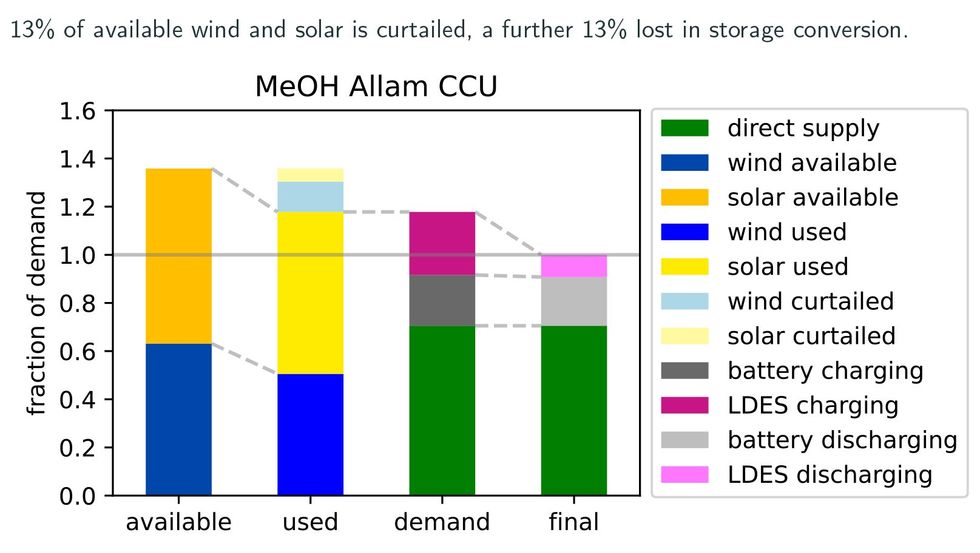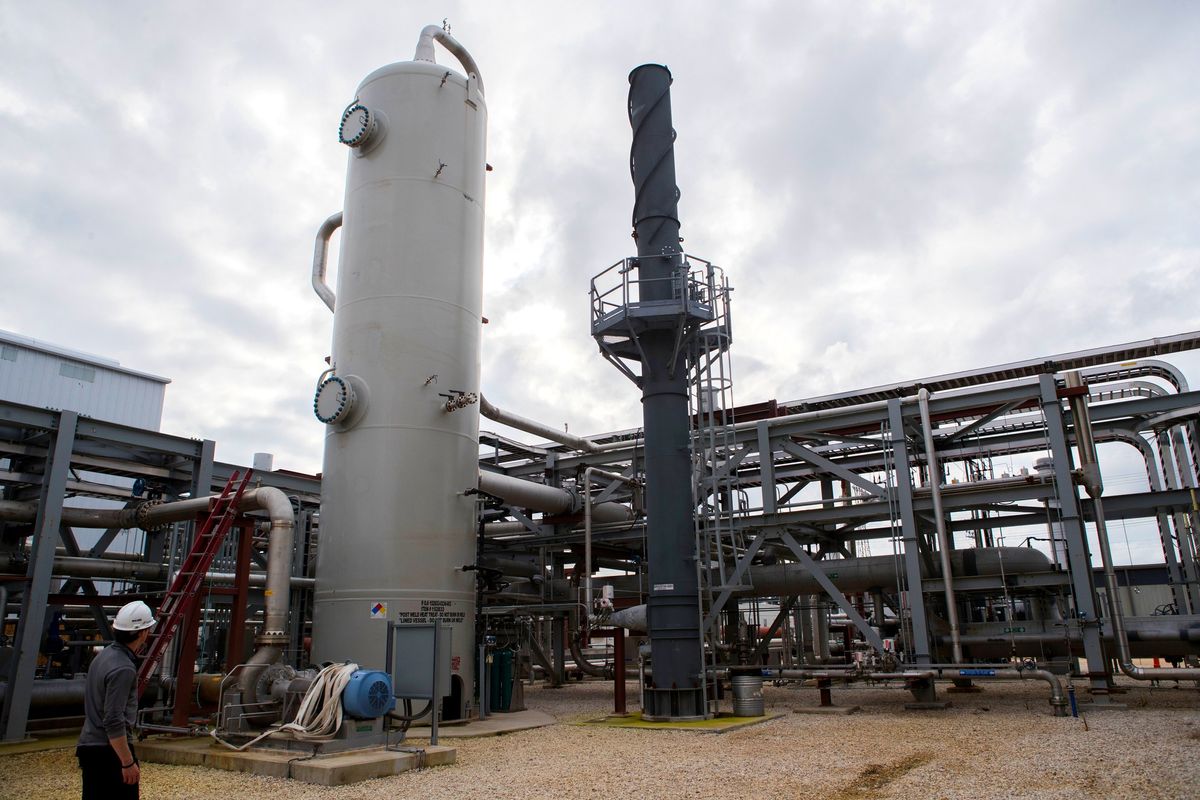It would be great if everyone could back up the intermittent power from wind and solar plants with energy stored as low-cost, zero-carbon hydrogen gas. But hydrogen can be hard to store.
Last month, when the Royal Society advised the British government to start building underground caverns to store megatons of hydrogen gas, it noted that the United Kingdom would need to store 1,000 times as much energy in this way as its pumped hydropower reservoirs can hold, and far more than batteries can feasibly provide. And the U.K. is fortunate to have hollowed-out underground salt deposits in which to put the gas. Others do not. The Pacific coast of the United States, for instance, has no appropriate geological formations. They are also rare across China, Africa, and South America.
Such cavern-challenged places may instead benefit from a creative workaround developed by German researchers: converting hydrogen to methanol. “Methanol presents a nice alternative to hydrogen, since as a liquid you can store it in tanks anywhere,” says energy-modeling expert Tom Brown, who heads the Department of Digital Transformation in Energy Systems at the Technische Universität Berlin.
Today in the journal Joule, Brown and Johannes Hampp, a doctoral researcher at the Potsdam Institute for Climate Impact Research, in Germany, report that storing energy as methanol can be cost effective. The key is to integrate equipment producing hydrogen, methanol, and electricity, all of which are being commercialized or are in industrial development.
Low-carbon methanol production is already scaling up to replace the dirty bunker fuel that propels big ships. And the specific type of power generator required has been demonstrated at a 25-megawatt plant in Texas.
The LaPorte, Texas, generating station, covered by IEEE Spectrum in 2018 along with process inventor Rodney Allam, burns natural gas with pure oxygen from a dedicated air separator. The Allam cycle, which bears his name, combusts fuel in a circulating stream of carbon dioxide that’s heated and compressed to form a pseudoliquid known as a supercritical fluid. After the supercritical gas expands to drive a turbine generator, excess carbon dioxide created by the combustion reaction is easily bled off. This allows a process to capture the carbon without the inefficiencies associated with separating carbon dioxide from a regular turbine’s exhaust.
NET Power, the LaPorte plant’s developer may sell the captured carbon dioxideto oil fields, which use it to boost petroleum extraction. That would diminish the Allam cycle’s climate-benefiting effect. But investors seem unfazed: NET Power raised over US $675 million earlier this year to build a 300-MW commercial-scale plant in Texas, which the company plans to start operating in 2026.
Repurposing the Allam cycle to burn methanol in an all-renewable energy system was first proposed in 2019 by engineers at the Netherlands’ University of Twente. Their integrated storage system, a closed loop that contains the Allam cycle, works as follows:
- Electrolysis splits water molecules into their constituent elements, hydrogen and oxygen;
- Hydrogen is made to react with carbon dioxide, producing methanol;
- Methanol is stored in tanks until required as a backup for shortfalls in renewable power generation;
- Methanol and oxygen are burned in the Allam cycle to generate power; and
- Surplus carbon dioxide loops back to step No. 2, where it is used to synthesize more methanol.
Brown and Hampp simulated renewable power systems for Germany, Spain, and the U.K., optimized each to use the methanol storage loop, and ran the resulting grids through the 71 years of weather recorded between 1950 and 2020. The resulting simulations tapped methanol to supply 7 to 9 percent of the power demand in an average year by storing enough for as much as 92 days of power generation.

According to Brown, a single tank of 200,000 cubic meters can hold enough methanol to generate 580 gigawatt-hours of electricity—enough to power Germany, Europe’s largest economy, for 10 hours.
Overall, they calculated that the cost of electricity from the grids would be between €77 and €94 per megawatt-hour delivered. That is well within the range that grid operators pay today to balance supply and demand via natural gas-fired power plants. Their modeling found that the methanol backup is also 29 to 43 percent cheaper than that of alternate grids backed up with hydrogen that must be stored in above-ground steel vessels, then converted to power in gas-fired generators.
Today’s report confirms that hydrogen stored below ground, in salt caverns, is the cheapest option of all—about 14 to 17 percent cheaper than methanol-stored energy. Brown says that means using hydrogen directly is generally preferable where geology provides the required salt caverns.
Thomas Overbye, director of Texas A&M University’s Smart Grid Center, says power-grid planners absolutely need to begin preparing for what his group calls renewable resource droughts. “We’re putting a lot of eggs in these renewable baskets. Most of the time they’re going to work as advertised, but we’re going to run into situations where they don’t,” says Overbye.
Research led by Overbye’s recently graduated doctoral student Jessica Wert, now a power systems engineer at Lawrence Livermore National Laboratory, found that U.S. states regularly experience periods of 48 hours or more where wind or solar resources fall well below seasonal norms. California, for example, experienced two-dozen “solar resource droughts” between 1973 and 2022. In the same period Iowa experienced 158 wind droughts, three of which lasted a full week.
Overbye says storing energy by converting wind and solar to hydrogen is a potential solution. But he and Wert note that there are other options, as well. One is building long-distance interconnections between regions, and thus enabling one region experiencing a wind or solar drought to tap another region that may have a surplus.
Brown, however, notes that transmission lines can take a decade or longer to build. He notes that an advantage for methanol-based energy storage, in particular, is that it avoids the need for new infrastructure that covers long distances. In fact, says Brown, the ability to put an integrated methanol system anywhere could make it the go-to storage option even in some regions that could store hydrogen more cheaply underground.
Methanol may even share the storage lift in the relatively compact U.K., based on Brown’s assessment of the Royal Society’s hydrogen storage plans. “You’d need a ton of electricity pylons and cables to bring electricity to the electrolyzers at the salt caverns, or a ton of hydrogen pipelines to move the hydrogen around,” says Brown.
Methanol storage might be much faster to build, and Brown says speed matters: “We’re now at the point of climate breakdown, where speed is more important than efficiency.”
- Hydrogen Battery "Sponges" Store Solar for the Grid - IEEE Spectrum ›
- Redox-Flow Cell Stores Renewable Energy as Hydrogen - IEEE ... ›
- How Inexpensive Must Energy Storage Be for Utilities to Switch to ... ›
Peter Fairley has been tracking energy technologies and their environmental implications globally for over two decades, charting engineering and policy innovations that could slash dependence on fossil fuels and the political forces fighting them. He has been a Contributing Editor with IEEE Spectrum since 2003.



